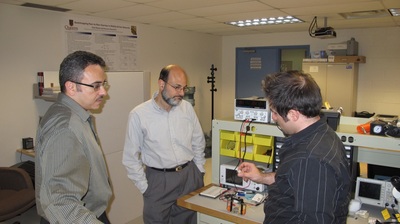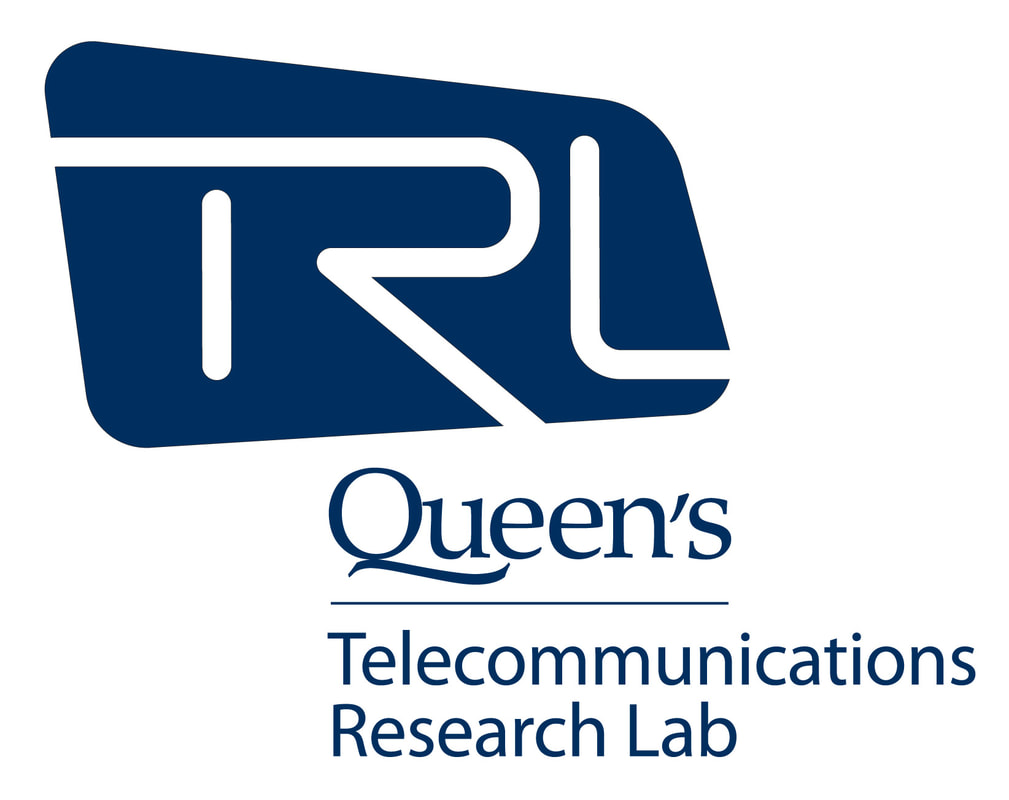Current Projects
Machine Intelligence and Big Data Analytics for 5G Networks and Beyond
5G networks and beyond are anticipated to transform modern societies by providing an ultra-reliable high-speed communications infrastructure that will serve billions of devices, machines and vehicles. 5G technology enables several advancements, including low latency, high mobility, high connection density, and high throughput. Technologies like network slicing and network virtualization are being introduced to support diverse service needs, and they will bring management challenges due to the need to configure and optimize many parameters. The complexity of 5G networks and beyond will be unprecedented due to the diverse applications, ultra-low latency requirements for mission-critical communication, and dense, heterogeneous architectures.
Artificial Intelligence (AI) has been recently explored to maximize the capabilities of 5G networks, adapt to the continually changing operating environment and enable various applications and services. Machine Learning (ML) is one of the primary forms of AI that can be used in 5G network deployment. We, therefore, design and develop ML-based solutions for 5G networks. The proposed solutions follow a holistic approach to future 5G service delivery, providing a unified integration framework based on machine intelligence to derive 5G network performance models and to achieve network intelligence and autonomous adaptability that rely on collecting real network data. These models will be used to develop anticipatory and agile 5G architectures and a data-driven radio resource management framework.
We create unique design and integration specifications, new service and information management techniques for future 5G networks, and algorithms to facilitate real-time radio resource management. The project consists of three main components: 1) Network Intelligence Engine (NIE), in which we develop 5G network models that capture how LTE and New Radio (NR) KPIs vary with network configuration, traffic load, and weather conditions. Another core aspect of the NIE is to develop network-wide predictions of traffic in space and time and enable individual user-level predictions of mobility and traffic patterns; 2) Agile 5G Architectures using Predictive Analytics: We use the predictive models developed in the NIE to design agile 5G architectures that handle variable 5G network demand with low CAPEX; and 3) Data-Driven Radio Resource Management: We focus on improving the service experienced at the individual user level, where the NIE models for individual user mobility and traffic flow will be leveraged.
Artificial Intelligence (AI) has been recently explored to maximize the capabilities of 5G networks, adapt to the continually changing operating environment and enable various applications and services. Machine Learning (ML) is one of the primary forms of AI that can be used in 5G network deployment. We, therefore, design and develop ML-based solutions for 5G networks. The proposed solutions follow a holistic approach to future 5G service delivery, providing a unified integration framework based on machine intelligence to derive 5G network performance models and to achieve network intelligence and autonomous adaptability that rely on collecting real network data. These models will be used to develop anticipatory and agile 5G architectures and a data-driven radio resource management framework.
We create unique design and integration specifications, new service and information management techniques for future 5G networks, and algorithms to facilitate real-time radio resource management. The project consists of three main components: 1) Network Intelligence Engine (NIE), in which we develop 5G network models that capture how LTE and New Radio (NR) KPIs vary with network configuration, traffic load, and weather conditions. Another core aspect of the NIE is to develop network-wide predictions of traffic in space and time and enable individual user-level predictions of mobility and traffic patterns; 2) Agile 5G Architectures using Predictive Analytics: We use the predictive models developed in the NIE to design agile 5G architectures that handle variable 5G network demand with low CAPEX; and 3) Data-Driven Radio Resource Management: We focus on improving the service experienced at the individual user level, where the NIE models for individual user mobility and traffic flow will be leveraged.
A Framework for Democratized Edge Computing and Intelligence
Edge computing (EC) has been proven to have a significant impact on offloading traffic/computations/Edge Intelligence (EI) tasks from backhaul links and improving users’ Quality of Service (QoS). The vast majority of developed EC/EI models and implemented platforms consist of dedicated infrastructure-based edge nodes (e.g., edge servers, base stations, and smart access points) that are solely controlled by cloud service providers and network operators. To break this monopoly and enable more players to construct and control their own edge cloud, we design and implement a complete democratized edge framework (DEF) that provides seamless non-monopolized EC and EI services to businesses and enterprises.
DEF revolutionarily transforms the already existing yet latent computing resources into on-demand clusters of distributed EC/EI workers. Examples of such resources include user-owned smartphones, laptops, tablets, IoT devices, smart appliances, connected vehicles, as well as computing infrastructures of various public, private, and educational institutions (e.g., servers, workstations, and computer labs during low/non-working hours). We establish innovative multi-objective protocol designs and cross-layer algorithmic procedures for worker recruitment/benchmarking, system/network resource allocation, and task placement/scheduling/migration/replication that collectively enable the deployment of distributed EC and EI jobs, with service guarantees, on large-scale systems of non-proprietary, geographically-dispersed, extremely-heterogeneous and/or resource-constrained wired and wireless workers.
The ground-breaking materialization of this complete framework for large-scale democratized EC and EI will not only reduce monopolies but will also enable: 1) Affordable access to edge computing resources for more users. 2) An open market for businesses, institutions, and even individuals to opt-in and monetize their unused/underused computing resources. 3) Easy development and provisioning of EC and EI services by non-tech businesses. 4) Ground-breaking physical and logical procedures that empower decentralized EC and EI, which can play an instrumental role in materializing smart cities solutions. Thus, democratizing EC and EI opens an entirely new tech market that is people-owned, democratically governed, and accessible/profitable to all.
DEF revolutionarily transforms the already existing yet latent computing resources into on-demand clusters of distributed EC/EI workers. Examples of such resources include user-owned smartphones, laptops, tablets, IoT devices, smart appliances, connected vehicles, as well as computing infrastructures of various public, private, and educational institutions (e.g., servers, workstations, and computer labs during low/non-working hours). We establish innovative multi-objective protocol designs and cross-layer algorithmic procedures for worker recruitment/benchmarking, system/network resource allocation, and task placement/scheduling/migration/replication that collectively enable the deployment of distributed EC and EI jobs, with service guarantees, on large-scale systems of non-proprietary, geographically-dispersed, extremely-heterogeneous and/or resource-constrained wired and wireless workers.
The ground-breaking materialization of this complete framework for large-scale democratized EC and EI will not only reduce monopolies but will also enable: 1) Affordable access to edge computing resources for more users. 2) An open market for businesses, institutions, and even individuals to opt-in and monetize their unused/underused computing resources. 3) Easy development and provisioning of EC and EI services by non-tech businesses. 4) Ground-breaking physical and logical procedures that empower decentralized EC and EI, which can play an instrumental role in materializing smart cities solutions. Thus, democratizing EC and EI opens an entirely new tech market that is people-owned, democratically governed, and accessible/profitable to all.
Sensing and Monitoring in Industrial and Transportation Applications
We utilize state-of-the art communication protocols and components to deliver robust and reliable sensor networks www.sensornodes.com . Our platforms comprise high quality SoC components, ultra-low power MCUs, and accurate small footprint sensing elements. The SPROUTS sensor platform is designed for harsh environments while ACES is designed for transportation and location-aware applications.
SPROUTS is a readily deployable, physically rugged, volumetric miniature, modular, network standard, energy-harvesting and plug-and-play sensor platform. The TRL team fully implemented the hardware, network, and software architecture for SPROUTS and field tested it in a number of harsh environments. The SPROUTS platform enables university researchers, developers, and industrial companies to evaluate WSN applications in the field, and potentially bring about new application domains that were previously difficult to accomplish. SPROUTS also enables over the air reprogramming without the need for reboot or external flash by effectively using clone detection techniques (a first in the literature).
ACES utilizes location information to optimize its battery life-time, reporting frequency, sensing frequency and its internal processing. In ACES, location nodes advertise location upon node entrance to a given zone and the node modifies its properties according to our Smart Profiling Algorithms (SPA).
SPROUTS is a readily deployable, physically rugged, volumetric miniature, modular, network standard, energy-harvesting and plug-and-play sensor platform. The TRL team fully implemented the hardware, network, and software architecture for SPROUTS and field tested it in a number of harsh environments. The SPROUTS platform enables university researchers, developers, and industrial companies to evaluate WSN applications in the field, and potentially bring about new application domains that were previously difficult to accomplish. SPROUTS also enables over the air reprogramming without the need for reboot or external flash by effectively using clone detection techniques (a first in the literature).
ACES utilizes location information to optimize its battery life-time, reporting frequency, sensing frequency and its internal processing. In ACES, location nodes advertise location upon node entrance to a given zone and the node modifies its properties according to our Smart Profiling Algorithms (SPA).
Ubiquitous Global Sensing
There is an abundance, and growing redundancy, of sensing systems that exist in isolation to build a framework for Ubiquitous Global Sensing (UGS). WSNs have long been dominated by an application-specific thrust but, by enhancing WSNs through a UGS platform, we can encompass resources that are abundant across heterogeneous platforms and enlist the resources of wireless devices in network vicinities. UGS architecture can enhance performance, improve the quality of data gathered and present an intrinsically scalable architecture that dynamically responds to sensing needs. To encourage multiple-network owners to contribute resources, we introduce pricing mechanisms for dynamic payment schemes. Unique to my approach, we will integrate the resources increasingly abundant in today’s smartphones and smart vehicles, as well as those found in industrial, municipal and proprietary sensors. In the course of this research program, we will create test beds for performance evaluation and prototype sensing systems that depict the dynamic nature of the UGS paradigm. In addition, this research program will tackle the critical issue of retaining data collected by sensors, even when the network fails to communicate it. Through UGS, we introduce a paradigm shift to on-demand WSNs based on the available sensors in the region of interest.
Under this research program, we: i) design and establish a resilient core for synergy efforts in heterogeneous sensing systems, empowering a scalable paradigm by pervasively encompassing disparate sensing systems, instilling mechanisms for utilizing both static and mobile resources to leverage performance; ii) facilitate resource utilization through accommodating simultaneous applications via resource sharing and trading, to establish mechanisms for autonomous WSNs scaling in the dimensions of density, area, physical (hardware) capabilities or logical (software) capabilities; iii) instil collusion-free economic models to incentivize resource sharing under the UGS vision; iv) ensure data collected over multiple WSNs survives different types and rates of failures, based on their quality and critical metrics, until network maintenance reinstates operation.
Under this research program, we: i) design and establish a resilient core for synergy efforts in heterogeneous sensing systems, empowering a scalable paradigm by pervasively encompassing disparate sensing systems, instilling mechanisms for utilizing both static and mobile resources to leverage performance; ii) facilitate resource utilization through accommodating simultaneous applications via resource sharing and trading, to establish mechanisms for autonomous WSNs scaling in the dimensions of density, area, physical (hardware) capabilities or logical (software) capabilities; iii) instil collusion-free economic models to incentivize resource sharing under the UGS vision; iv) ensure data collected over multiple WSNs survives different types and rates of failures, based on their quality and critical metrics, until network maintenance reinstates operation.





